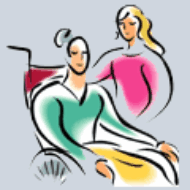No one wants to think about injury or illness, and sometimes hearing the words, “You need to attend physical therapy” can be frightening. However, many times, after proper training and one-on-one time with a qualified physical therapist, you or your loved one can continue physical therapy with a few simple pieces of equipment in your home.
At-Home Physical Therapy
Sometimes being in the comfort and privacy of your own home can help you heal, mend or even train for a sporting event. Post-surgical recovery often requires physical therapy, especially when muscles or joints are involved. Athletes training for weight lifting or cardiovascular events after injury also muscle-strengthening regimens, and doing these exercises at home saves time and visits to the clinic.
Upper Body Exerciser
These are also known as an upper body ergometers. Larger versions used in physical therapy offices have adjustable seat and height settings with digital displays; these can be cost thousands of dollars and often require pre-approval and a doctor’s prescription for home use. Smaller, simpler versions for the home are available to put on a counter or tabletop. These devices work the upper arms, chest and elbow areas. The cost is relatively low from $50 to $200 depending on the options you choose.
Pedal Exerciser
Again, there are varying types of Pedal exercisers. The ones in the physical therapist’s office are quite expensive (thousands of dollars) and come with many more options than you’ll need for home use. A simple stationary bike can work the same group of leg muscles, ankles and knees for around $300. Be sure your therapist recommends this option depending on your ability to use a bicycle seat and/or back posture concerns. Another great option is a simple floor model that you can use while working at a desk or watching TV. These types of exercisers range from $30 to $200, again depending on the settings and options you wish to have.
Gripping Aids
If you’ve injured your hand, have arthritis, residual stroke symptoms or carpal tunnel issues, your therapist may recommend strengthening and Grip aids for at-home use. Gripping aids are typically worn as a glove on the injured or affected hand, similar to what gymnasts use in competition. They reduce the stress on your tendons and allow you to hold onto things with more confidence. Quality grip gloves run from $30 up to $150 and come with directions on how to keep them clean. A therapist may want to measure and fit you for such a glove. Other devices, like therapy putty, stress balls and spring-loaded grippers, may be recommended to continue hand exercises at home.
Physical therapy devices require little maintenance and upkeep, and benefit the patient in the home environment by allowing them freedom to recover in privacy and saving time and money in the long-run.
